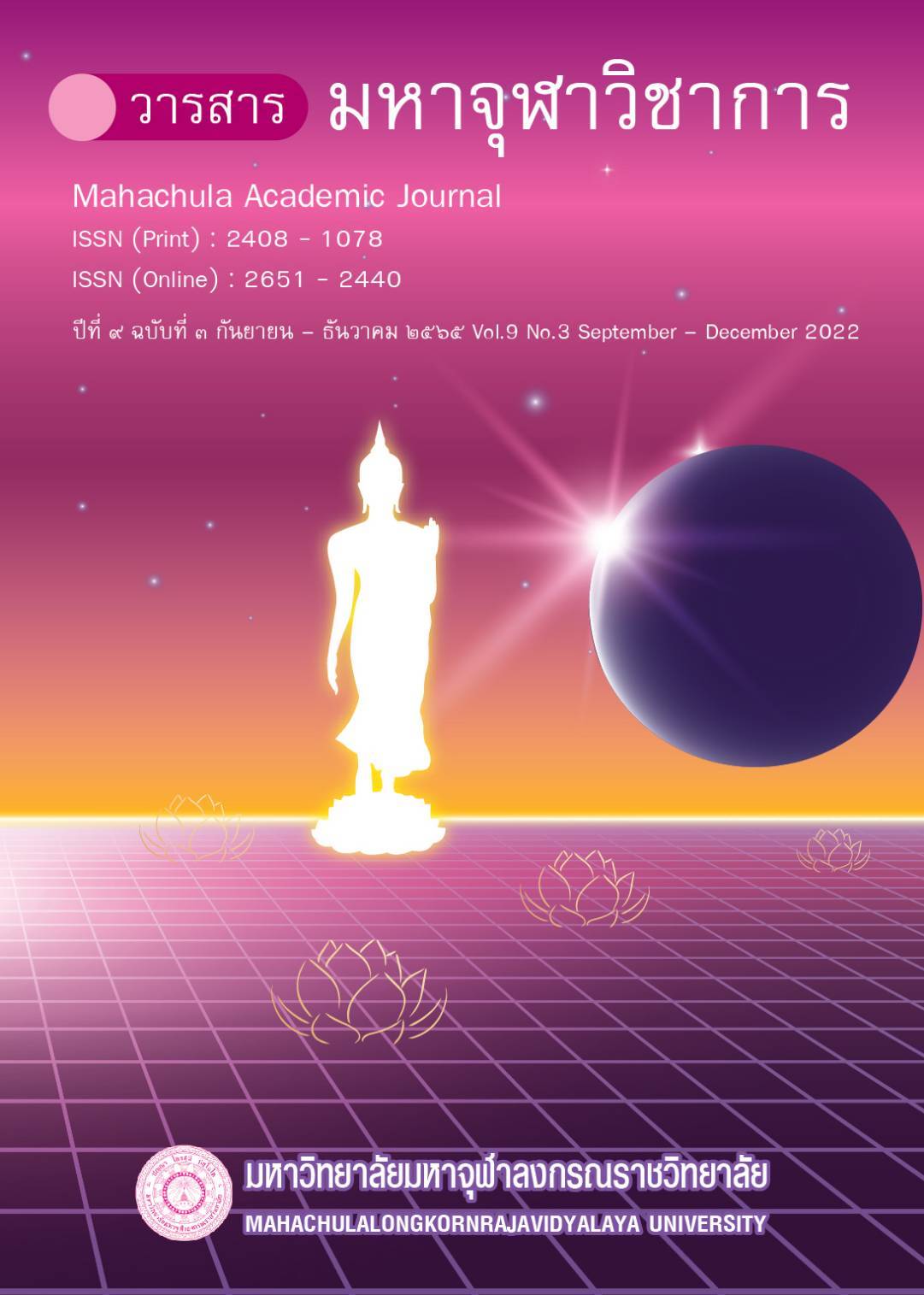ผลการจัดกิจกรรมการเรียนรู้ภาษาอังกฤษโดยใช้ การสอนภาษาเพื่อการสื่อสาร (CLT) ร่วมกับการจัดการเรียนรู้แบบ ห้องเรียนกลับด้าน (FLIPPED CLASSROOM) ที่มีต่อผลสัมฤทธิ์ทางการเรียน วิชาภาษาอังกฤษและความพึงพอใจของนักเรียนชั้นมัธยมศึกษาปีที่ ๓
Main Article Content
บทคัดย่อ
การวิจัยในครั้งนี้มีวัตถุประสงค์เพื่อ (๑) ศึกษาผลสัมฤทธิ์ทางการเรียนก่อนและหลังจากการได้รับการจัดกิจกรรมการเรียนรู้ภาษาอังกฤษโดยใช้การสอนภาษาเพื่อการสื่อสาร (CLT) ร่วมกับการจัดการเรียนรู้แบบห้องเรียนกลับด้าน (FLIPPED CLASSROOM) (๒) ศึกษาความพึงพอใจของนักเรียนที่มีต่อการจัดกิจกรรมการเรียนรู้ภาษาอังกฤษโดยใช้การสอนภาษาเพื่อการสื่อสาร (CLT) ร่วมกับการจัดการเรียนรู้แบบห้องเรียนกลับด้าน (FLIPPED CLASSROOM) กลุ่มตัวอย่างเป็นนักเรียนของนักเรียนชั้นมัธยมศึกษาปีที่ ๓/๑ โรงเรียนบ้านสวนอุดมวิทยา จำนวน ๑ ห้องเรียน ๒๘ คน ซึ่งได้มาจากการสุ่มตัวอย่างแบบกลุ่ม (Cluster Random Sampling) เครื่องมือที่ใช้ในการวิจัยได้แก่ (๑) แผนการจัดกิจกรรมการเรียนรู้รายวิชาภาษาอังกฤษ ชั้นมัธยมศึกษาปีที่ ๓ จำนวน ๖ แผน (๒) แบบทดสอบวัดผลสัมฤทธิ์ทางการเรียนวิชาภาษาอังกฤษ เป็นแบบปรนัยชนิดเลือกตอบ ๔ ตัวเลือก จำนวน ๓๐ ข้อ (๓) แบบประเมินความพึงพอใจของนักเรียนที่มีต่อการจัดกิจกรรมการเรียนรู้ภาษาอังกฤษโดยใช้การสอนภาษาเพื่อการสื่อสาร (CLT) ร่วมกับการจัดการเรียนรู้แบบห้องเรียนกลับด้าน (FLIPPED CLASSROOM) โดยใช้แบบประเมินในลักษณะมาตราประมาณค่า ๕ ระดับจำนวน ๑๖ ข้อ รูปแบบการวิจัยครั้งนี้เป็นการวิจัยแบบกึ่งทดลอง มีแผนการวิจัยแบบ One Group Pretest – Posttest Design สถิติที่ใช้ในการวิเคราะห์ข้อมูลคือค่าร้อยละค่าเฉลี่ย ส่วนเบี่ยงเบนมาตรฐานและค่าทดสอบที (t-test dependent)
ผลการวิจัยพบว่า (๑) ผลสัมฤทธิ์ทางการเรียนวิชาภาษา อังกฤษ ของนักเรียนชั้นมัธยมศึกษาปีที่ ๓ ที่ได้รับการจัดกิจกรรมการเรียนรู้ภาษาอังกฤษโดยใช้การสอนภาษาเพื่อการสื่อสาร (CLT) ร่วมกับการจัดการเรียนรู้แบบห้องเรียนกลับด้าน (FLIPPED CLASSROOM) หลังเรียนสูงกว่าก่อนเรียนอย่างมีนัยสำคัญทางสถิติที่ระดับ .๐๕ (๒) ผลการศึกษาความพึงพอใจของนักเรียนที่มีต่อการจัดกิจกรรมการเรียนรู้ภาษาอังกฤษโดยใช้การสอนภาษาเพื่อการสื่อสาร (CLT) ร่วมกับการจัดการเรียนรู้แบบห้องเรียนกลับด้าน (FLIPPED CLASSROOM) พบว่า ภาพรวมคะแนนเฉลี่ยความพึงพอใจของนักเรียนอยู่ในระดับดี (X̅= ๔.๕๒, SD = ๐.๕๐)
Article Details

อนุญาตภายใต้เงื่อนไข Creative Commons Attribution-NonCommercial-NoDerivatives 4.0 International License.
เอกสารอ้างอิง
กระทรวงศึกษาธิการ. หลักสูตรแกนกลางการศึกษาขึ้นพื้นฐานพุทธศักราช ๒๕๕๑. กรุงเทพมหานคร : โรงพิมพ์คุรุสภาลาดพร้าว, ๒๕๕๑), หน้า ๒๒๐.
เกรียงไกร สกุลประเสริฐศรี, จุฑารัตน์ วิบูลผล. “ผลของการสอนภาษาอังกฤษโดยใช้แนวคิดการเรียนรู้แบบห้องเรียนกลับด้านที่มีผลต่อความสามารถในการพูดภาษาอังกฤษเพื่อการสื่อสาร และแรงจูงใจในการเรียนภาษาอังกฤษของนักเรียนมัธยมศึกษาตอนปลาย”. วารสารครุศาสตร์ จุฬาลงกรณ์มหาวิทยาลัย. ปีที่ ๔๔ ฉบับที่ ๓ (กรกฎาคม - กันยายน) หน้า ๒๙-๔๕.
เจเรมี ฮาร์เมอร์. How to teach English (วิธีสอนภาษาอังกฤษ). กรุงเทพมหานคร : เพียร์สัน เอ็ดดูเคชั่นอินโดไชน่า จำกัด, ๒๕๔๖ หน้า ๔๓-๔๕.
ฐานิตา ลิ่มวงศ์, ยุพาภรณ์ แสงฤทธิ์. “ห้องเรียนกลับด้าน : การเรียนรู้แนวใหม่สำหรับศตวรรษที่ ๒๑”. วารสารMahidol R2R e-Journal. ปีที่ ๖ ฉบับที่ ๒ (กรกฎาคม – ธันวาคม ๒๕๖๒) : ๑๐-๑๖.
นวลปราง เขจรสัตย์. “การพัฒนาทักษะการพูดภาษาอังกฤษเพื่อการสื่อสารของนักเรียนชั้นมัธยมศึกษาปีที่ ๔ โดยใช้กิจกรรมการเรียนรู้ภาษาเพื่อการสื่อสาร. วิทยานิพนธ์ปริญญาศึกษาศาสตรมหาบัณฑิต, สาขาวิชาหลักสูตรและการสอน บัณฑิตวิทยาลัย มหาวิทยาลัยขอนแก่น : ๒๕๕๖.
บุญชม ศรีสะอาด. วิธีการทางสถิติสำหรับการวิจัย. พิมพ์ครั้งที่ ๕. กรุงเทพมหานคร : สุวีริยาสาส์น, ๒๕๕๖.
พิมพ์ประภา พาลพ่าย, ณัฐพล รำไพ. การใช้สื่อสังคมตามแนวคิดห้องเรียนกลับด้าน เรื่อง ภาษาเพื่อการสื่อสารเพื่อส่งเสริมผลสัมฤทธิ์ทางการเรียนของนักเรียนชั้นมัธยมศึกษาปีที่ ๖. วิทยานิพนธ์ปริญญาศึกษาศาสตรมหาบัณฑิต. สาขาวิชาเทคโนโลยและสื่อสารการศึกษา มหาวิทยาลัยเกษตรศาสตร์ : ๒๕๕๗.
สำนักงานเลขาธิการสภาการศึกษา. แผนการศึกษาแห่งงชาติ พ.ศ. ๒๕๖๐-๒๕๗๙. กรุงเทพมหานคร : พริกหวานกราฟฟิก จำกัด, ๒๕๖๐ หน้า ๗๖-๗๘.
Cronbach, L. J. Essentials of Psychological Test (5th ed.). New York: Harper Collins, 1970.


